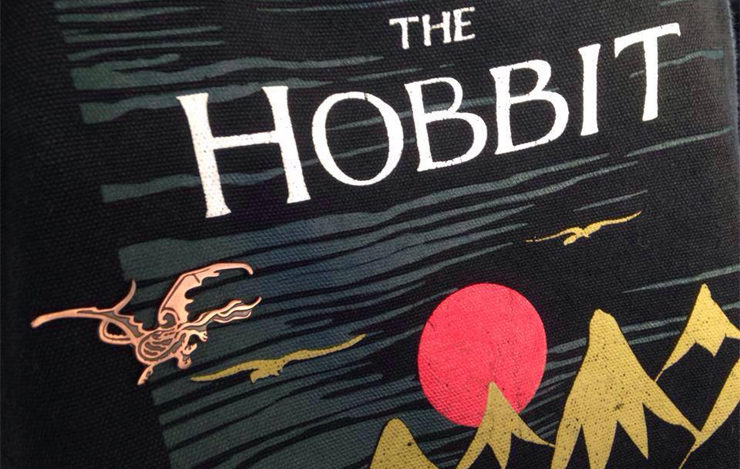In a hole in the ground lived one of literature’s smallest badasses, Bilbo Baggins, who in 1937 burst onto the scene in a ring of smoke. That’s right: 80 years ago this week, J.R.R. Tolkien’s fur-footed, waistcoat-wearing protagonist went there and back again for the very first time when George Allen & Unwin Ltd. published The Hobbit.
When it first landed, The Hobbit was a hit, and early readers understandably compared it to Lewis Carroll’s Alice’s Adventures in Wonderland because it’s not like the literary scene was exploding with dragons just yet. Disney’s animated Snow White and the Seven Dwarfs also came out later the same year, so at least there were some people of the short and bearded persuasion on the scene. Although I think we can agree that Thorin Oakenshield is a lot of things, but he sure ain’t Dopey.
But let’s get back to Bilbo, the bravest little hobbit of them all.
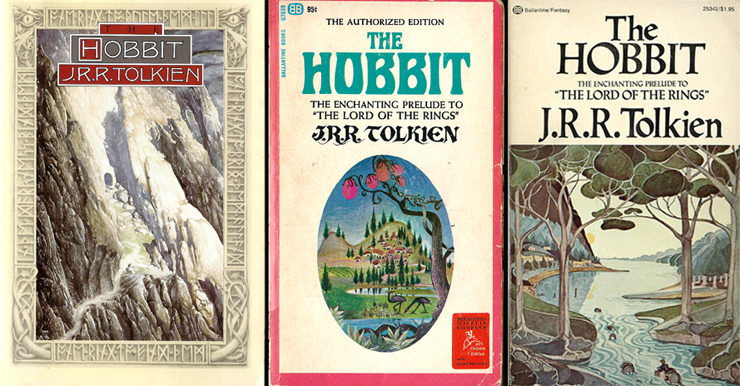
Every Tolkien fan has their own history with this character, this book, this author, and his other works—and if they’re really lucky, that exposure started in childhood. For me it certainly did. Old Tollers died years before I came along, but his legacy made the foundations of contemporary fantasy extremely fertile (and also, we have to admit, challenging to deviate from), not just for me but for the authors I grew up on. Halflings got built right into Dungeons & Dragons at the ground floor, even though the game’s co-creator Gary Gygax wasn’t actually a fan of the books and generally disliked hobbits. Heck, halflings got reimagined as the diminutive, klepto, fast-talking kender in the mid-80s Dragonlance books I dearly loved. Ahh, these were the actual Stranger Things days…
Speaking of nostalgia, it wasn’t strictly Tolkien’s text that kickstarted my lifelong fandom—before I ever encountered the book, my impressionable young mind was absolutely won over by the one Hobbit movie already in existence. I’m speaking, of course, about the 1977 Rankin/Bass animated film—made by the same production team that gave us that stop-motion TV holiday special Rudolph the Red-Nosed Reindeer, not to mention The Last Unicorn, and later The Return of the King itself.
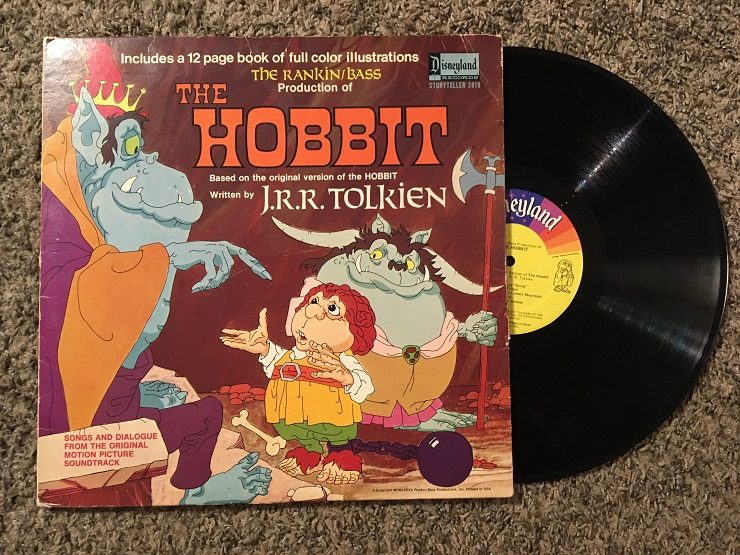
This 78-minute Hobbit was, to a kid like me—and tons of girls and boys—utterly perfect, utterly enchanting, and all that it needed to be. Like Bilbo, I felt “the love of beautiful things made by hands and by cunning and by magic moving through” me. As an adult, it still remains a truncated but no less delightful fairy tale, though it only dips a few furry toes into the splendorous waters of the full book. Sure, as a Tolkien nerd I can’t help but note every time the story skips ahead or changes something—but so what? It’s been said that Tolkien himself wasn’t too happy with The Hobbit being perceived as a children’s book, but this adaptation is certainly a children’s movie.
It’s sort of a reversal of the complaints many book fans voiced about the recent Peter Jackson Hobbit films. “Too long!” “Stretched out!” Whatever, says me. More is almost always more. I’ve discussed this issue at length already, though, and so I won’t revisit it here, but I have observed that moviegoers who are also book fans can get pretty bent out of shape if an adaptation doesn’t fall perfectly into the third, “just right” category, following the prerogative of Goldilocks. I even came across a scathing review of the Rankin/Bass production from issue #11 of The Dragon (what would become simply Dragon magazine later) from the year of its release. The editor concluded:
In summary, what we got was an inaccurate, poorly developed rehash of one of the finest fantasy novels ever written. Xerox, the sponsor, did not get its money’s worth in material.
Alas, I find adulthood to be cynical and overrated. Well, at least the reviewer liked the book! It’s an adaptation, not a pure book-to-film translation—not a Xerox copy, if you will—so of course it’s not going to please everyone.
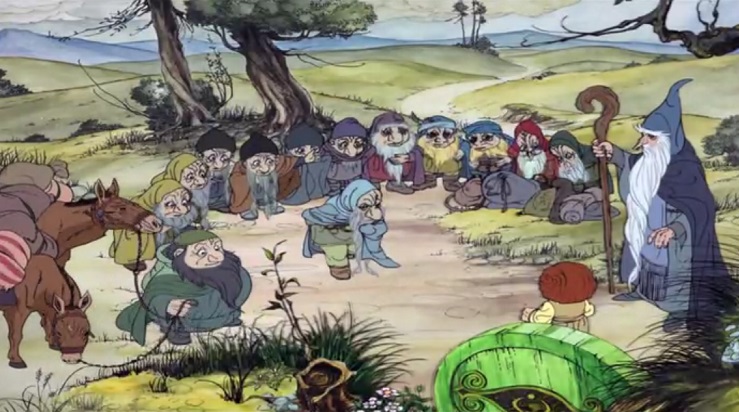
The TV movie first aired on November 27, 1977 on NBC, which means that as The Hobbit itself turns 80, the Rankin/Bass production is turning 40! In celebration of both, I’d like to talk about and appraise the film as an adult (but with one eye nostalgically unapologetic).
As I’ve said, I came to the book later, well after becoming completely enamored of this movie. And aside from inspiring me to want to live in Middle-earth pretty much all the time, it also helped establish some lifelong mental images of Tolkien’s world, in my imagination. Even though it’s a cartoon, the scenery is lovely, offering some of that often grey, washed-out, and watercolor style I would also recognize in Tolkien artist Alan Lee’s paintings. It gives the world an impressively ancient and storied quality.
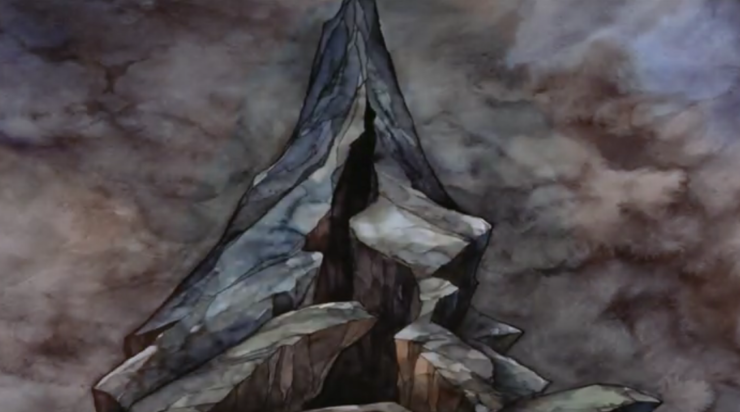
In fact, it seems to me that almost everyone who depicts Middle-earth landscapes, from painters to sketch artists to filmmakers, somehow always does a good job of making the world look “lived in.” I love that. Some fantasy stories are a bit too clean and perfect. Middle-earth looks old and weathered, like its maps.
If you’ve never seen this movie but are considering watching it, I should warn you: It will put some dippy 70s tunes in your head, but mostly in a good way. Mostly. After you’ve experienced the whole thing, if you don’t have Glenn Yarbrough’s warm and folky warbling of “The Greatest Adventure” popping up randomly in your head with from time to time throughout your life, I kind of feel like you’re missing out.
♩ ♪ The greatest adventure is what lies ahead
Today and tomorrow are yet to be said
The chances, the changes are all yours to make
The mold of your life is in your hands to breakThe greatest adventure is there if you’re bold
Let go of the moment that life makes you hold
To measure the meaning can make you delay
It’s time you stop thinkin’ and wasting the day ♫ ♬
Sorry—that’s sort of just playing on a loop in my psyche, forever.
Producer/writer/composer Jules Bass turned a number of the poems in The Hobbit into real songs without, mercifully, turning the whole thing into a musical. Every goddamned one of them is catchy, from the “Chip the glasses, crack the plates” to “Down down to Goblin-town” to “Roads go ever, ever on,” often performed by a chorus or else by Yarbrough and his zany vibrato. Even Gollum’s “darkness” riddle is played as an eerie interlude as our eyes pan across the walls of his dark cave, suggestive of the passing of time. It works well, and so in my mind, that riddle has remained exclusively in musical form ever since.
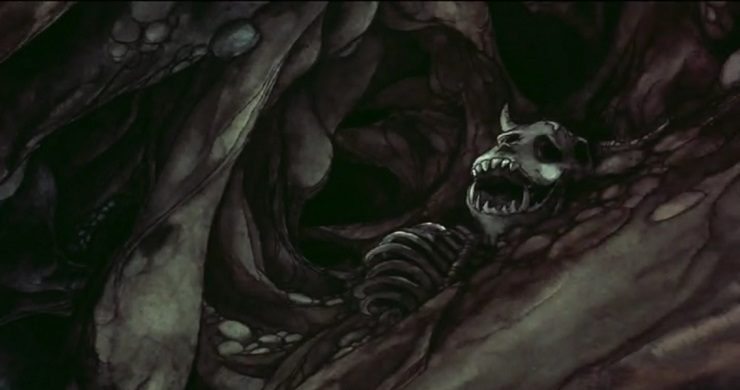
As far as the actual character design—their colors, their movements, their voices—there’s nothing ho-hum about this Hobbit. Some choices are good, some not so much. Adult me finds the cherubic Bilbo a little bit too round, maybe, but this is the Rankin/Bass style, and ultimately it’s a suitable shape for a hobbit. They “are inclined to be fat in the stomach” after all. And the dwarves, while a tad more craven than their book counterparts, are still quite fun—plenty of wagging beards and running away, tempered by bouts of stubbornness and pride. In fact, the first few minutes of the movie paint the perfect picture of the dwarves and their beautiful works in the Lonely Mountain as Thorin tells their story.
Of course, there are also some especially goofy choices, some of which hilariously date the production. Bard seems to be sporting a Tom Selleck mustache, the Wood-elves all look like leaf-wearing little blue Martians, and close-ups of Gandalf tend to make him look like a deranged, staff-wielding hobo. And what the hell is wrong with Balin’s forehead?

There have been some bizarre interpretations of Tolkien’s characters over the years—particularly pre-Jackson—but by and large the style choices in this movie feel appropriate to a kid’s sensibilities. Everyone has large eyes, noses are either huge and blocky (Bombur), long and narrow (Gandalf), or tiny (Gollum). The trolls and goblins all have massive horns or tusks. There’s a heck of a lot of beards and lots of long white or grey hair (but that’s always the case in Middle-earth). Everyone but Gollum seems to have a cape or cloak, even the goblins.
Interestingly, Smaug has decidedly feline features, mostly in the eyes, ears, and back-fur, but I find that lends itself well to his lounging atop the gold as if he were an enormous, lazy cat. The spiders of Mirkwood have actual faces and fanged mouths which, matched with the shrill voices they’re given, make them pretty damned freaky.
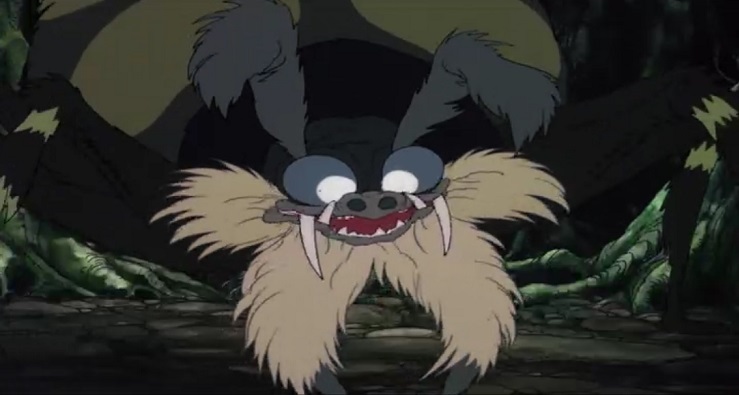
And the goblins! Their arrival, if you’re a little kid, is downright scary. They materialize out of the darkness slowly before revealing impossibly huge mouths. The Great Goblin himself looks like he could simply gobble Thorin up. They definitely terrified me the first time around. Bilbo and the dwarves are caught up quickly and humbled before them; goblins are intimidating with their chains and slavering tusks, and their rollicking all-bass choruses.
Down, down to Goblin-town they go. ♫ ♬ Now see if you can keep that tune out of your head, too…good luck, my lad.
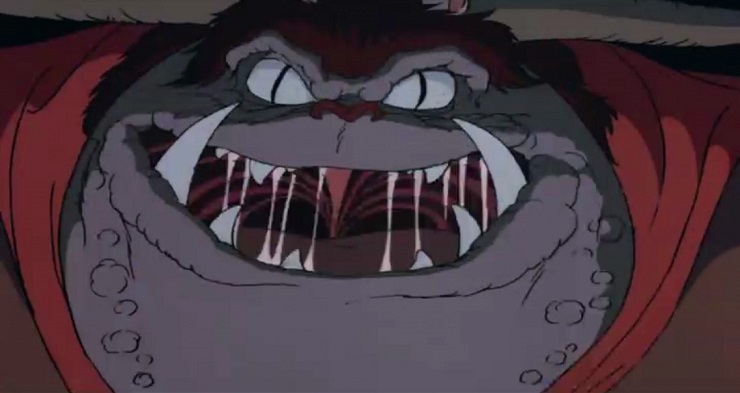
In stark contrast to the exaggerated body shapes of all the fantastical peoples and creatures in this film, the “normal” animals and the actual humans have realistic proportions. That should bother me, but somehow the juxtaposition works, particularly in the case of the wolves that the goblins ride, and also the eagles, who don’t disappoint, doing the swoop-in-suddenly thing that they’re best known for.
The voice acting ranges from over-the-top to downright goofy to spot on. Sixties TV actor Orson Bean characterizes Bilbo as both sunny and courageous when he’s not whimpering like Winnie the Pooh. Oh bother! And since Sir Ian McKellen isn’t voicing Gandalf here, I’m glad legendary Golden Age actor/director John Huston took the role (and whoa, he’s Anjelica Huston’s, aka Morticia Addams’s, dad!). Huston’s Gandalf comes across as sagely and grandfatherly with a touch of irritability, perfect for our favorite wizard. Thorin, who is especially cranky and demanding in this movie, is appropriately voiced by character actor Hans Conried, a regular on shows like I Love Lucy and The George Burns and Gracie Allen Show.
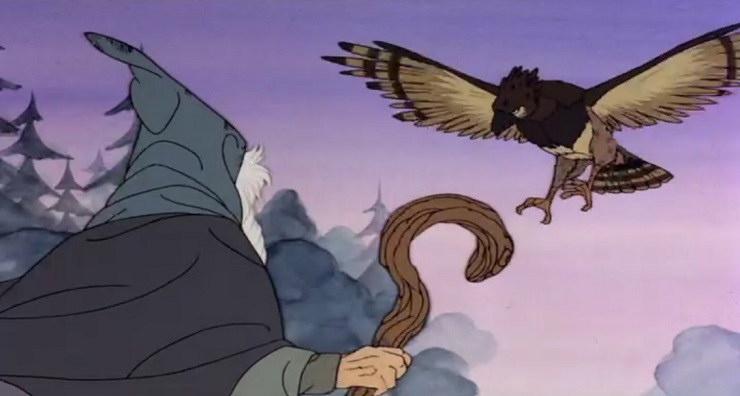
Casting director Otto Preminger in the role of the Elvenking strikes me as a bit odd, since I’ve personally never imagined Thranduil as speaking with an imperious Viennese accent, but I guess the Misty Mountains really have created a stronger cultural divide among Elves than I thought! Oh, and the guy who voices Gollum is totally the gruff older Klopek from The ‘Burbs. I can totally hear it now. (And if you don’t know The ‘Burbs, I’m sorry to hear that. You kids.)
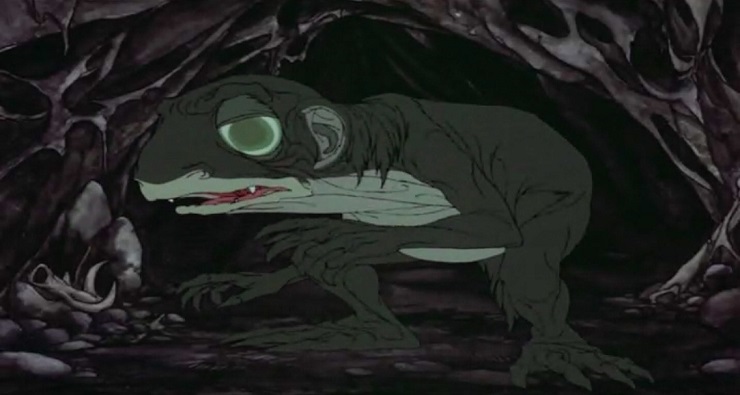
Sadly, Beorn didn’t make the cut—the eagles fly the company right to the edge of Mirkwood and that’s that. Also, no stone giants in the Misty Mountains, but that’s all right. Scenes are understandably rushed and some elements are trimmed right out to keep the runtime low. There’s no Laketown master, or really much talk about Dale at all. There’s no Arkenstone, no lasting debate about who should have the gold once the dragon is dead. The dwarves, elves, and humans are ready to come to blows pretty quick before the goblins and wolves show up. But you know what they kept in—and what I missed dearly in Jackson’s version? Talking animals! Which of course includes Bard’s thrush-delivered intel about Smaug’s missing scale; his Black Arrow moment is brief but memorable.
The use of darkness and especially of shadows is aesthetically brilliant throughout the film. We see the shadows of the dwarves on Bilbo’s wall, then those of their ancestors in the Lonely Mountain, and somehow that lends the most mundane of activities—tinkering or playing instruments—a mythic, legendary quality. Add the stirring voices of the men’s chorus behind it and you’ve got instant movie magic.
Along with the landscapes I mentioned earlier, my other favorite aspect of the visual artistry of this move is the look of fire, which appear as actual flames. We see it in flashbacks, in the pine trees as our heroes are escaping from the goblins, and of course—especially—with Smaug himself. The artists and animators of Topcraft, the Japanese anime studio that would later become Studio Ghibli, are to be extolled for this wonder. The fire curls and spirals, subtly at first, shot forward in thin rays before the overwhelming blast that follows. I could watch it all day. The overall style isn’t anime, but you can see the influence there.
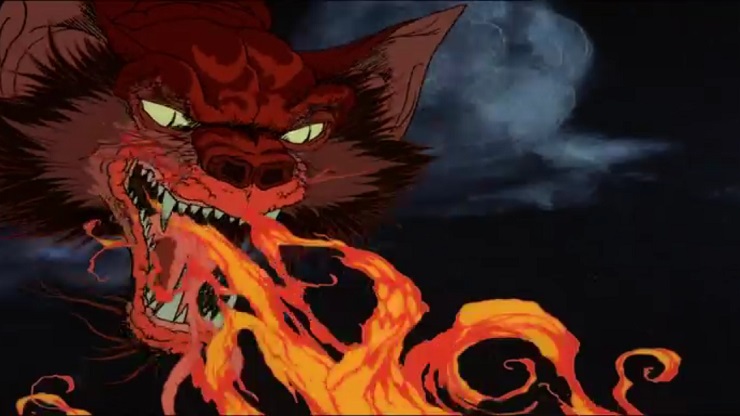
There are only two little cringe-worthy moments, from the perspective of an adult viewer who knows the books well. One is when Bilbo says “Ta-ta!” to Gollum as he hops over him, invisibly, during his escape. Because, c’mon. Tolkien would not have been okay with that (among other things). The other is when Gandalf summons the dawn itself to defeat the three trolls. As in, he just straight-up conjures it instead of, you know, tricking the trolls into losing track of time. (Psst! Ix-nay on the owers-pay, Mithrandir. You’re one of the Istari, for Eru’s sake. Keep your origin story on the down-low.) On the other hand, watching that scene as a kid? Gandalf made the sun come up! Yay, in your face, trolls!
The movie also kills off more dwarves than the book does, in the end. Which is weird. But then the film’s version of the Battle of the Five Armies, when shown from afar, also looks likes Pig-Pen’s family had big reunion or something, so… I guess not every frame of the animation can win First Prize.
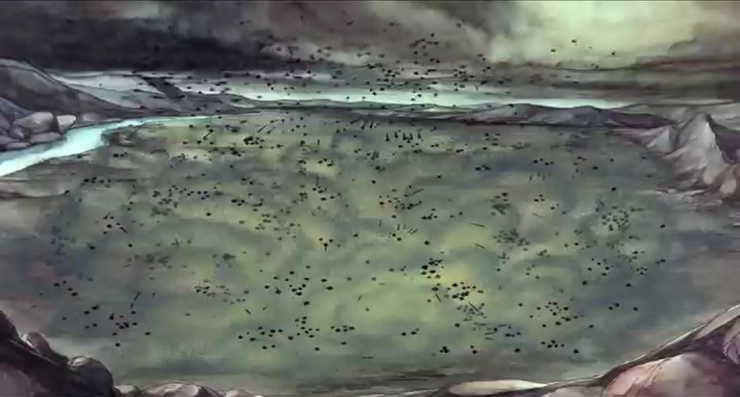
As with any adaptation, if you care about the source material, you care most about seeing its spirit maintained. I think Rankin/Bass managed that, even though there is actually a hell of a lot more going on in the original book—way more than you’d think at first gander. But the essential themes of embracing adventure, of turning cowardice into heroism, and of the curious nature of luck—it’s all there for the intended audience, the kids this film was made for.
My affection for The Hobbit was born out of this animated movie, making my appreciation of the book itself, and all that followed, an inevitability. Now I’m a new parent, and I’m biding my time, waiting for my son to be old enough to let me read it to him, while simultaneously trying to figure how not to come on too strong with this stuff. Probably impossible.
But hey, it’s not like I’d dress him up as a hobbit for Halloween twice in a row, right?

Oh, right. I did do that.
I should probably just start with this movie, though. I am very fond of it; but it is only quite a little movie in a wide world after all.
[A quick note for hardcore fans of The Hobbit—those like me who reread and try to encourage others to read it—you should know that the excellent The Prancing Pony Podcast is about to embark on an in-depth discussion of the book, with each episode dedicated to a chapter. Having tuned in for all their Silmarillion episodes, I can tell you firsthand that those guys are both insightful and entertaining. The Hobbit discussions will begin with Episode 053. Most recently, they spoke with Corey Olson, the Tolkien Professor (who did his own deeply insightful podcast series on this book), in Episode 052.]
Jeff LaSala is a production editor and freelance writer who can’t leave Middle-earth well enough alone (see The Silmarillion Primer, for example). He also wrote some sci-fi/fantasy books and now works for Tor Books. He also wants to point out that today and tomorrow are yet to be said. ♫ ♬










